|

PRESCRIPTION ACT 1832 - CHAPTER 71 2 and 3 Will 4
An Act for shortening the time of prescription in certain cases.
[1st August 1832]
Whereas the expression “time immemorial, or time whereof the memory of man runneth not to the contrary,” is now by the Law of England in many cases considered to include and denote the whole period of time from the Reign of King Richard the First, whereby the title to matters that have been long enjoyed is sometimes defeated by shewing the commencement of such enjoyment, which is in many cases productive of inconvenience and injustice;
[1.] Claims to right of common and other profits a prendre, not to be defeated after thirty years enjoyment by merely showing the commencement; after sixty years enjoyment the right to be absolute, unless had by consent or agreement.
No claim which may be lawfully made at the common law, by custom, prescription, or grant, to any right of common or other profit or benefit to be taken and enjoyed from or upon any land of our sovereign lord the King, or any land being parcel of the duchy of Lancaster or of the duchy of Cornwall, or of any ecclesiastical or lay person, or body corporate, except such matters and things as are herein specially provided for, and except tithes, rent, and services, shall, where such right, profit, or benefit shall have been actually taken and enjoyed by any person claiming right thereto without interruption for the full period of thirty years, be defeated or destroyed by showing only that such right, profit, or benefit was first taken or enjoyed at any time prior to such period of thirty years, but nevertheless such claim may be defeated in any other way by which the same is now liable to be defeated; and when such right, profit, or benefit shall have been so taken and enjoyed as aforesaid for the full period of sixty years, the right thereto shall be deemed absolute and indefeasible, unless it shall appear that the same was taken and enjoyed by some consent or agreement expressly made or given for that purpose by deed or writing.
2 In claims of right of way or other easement the periods to be twenty years and forty years.
No claim which may be lawfully made at the common law, by custom, prescription, or grant, to any way or other
easement, or to any watercourse, or the use of any water, to be enjoyed or derived upon, over, or from any land or water of our said lord the King, or being parcel of the duchy of Lancaster or of the duchy of Cornwall, or being the property of any ecclesiastical or lay person, or body corporate, when such way or other matter as herein last before mentioned shall have been actually enjoyed by any person claiming right thereto without interruption for the full period of twenty years, shall be defeated or destroyed by showing only that such way or other matter was first enjoyed at any time prior to such period of twenty years, but nevertheless such claim may be defeated in any other way by which the same is now liable to be defeated; and where such way or other matter as herein last before mentioned shall have been so enjoyed as aforesaid for the full period of forty years, the right thereto shall be deemed absolute and indefeasible, unless it shall appear that the same was enjoyed by some consent or agreement expressly given or made for that purpose by deed or writing.
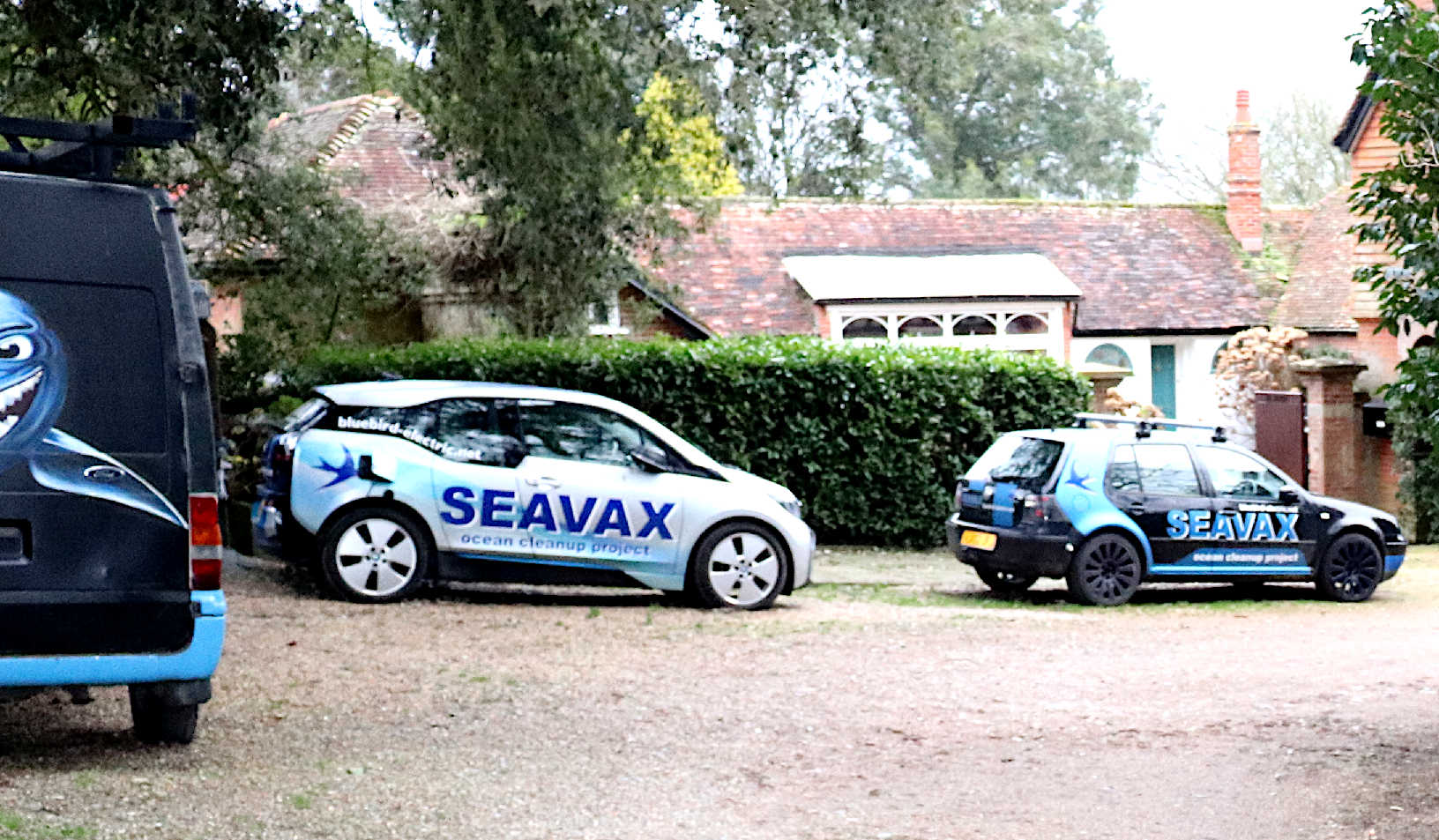
PARKING
PATTERN 2021 - Existing users of the early electricity generating
station, have been parking along this drive in this position since at
least late 1981. Thus, establishing an easement in their favour for
parking, that may not be taken away - it becoming an indefeasible right
after 2022. Nobody may interfere with this right, seek to take it away
or hinder such use, or face the legal consequences. Typically via
injunctions in the County or High Courts, attracting costs and damages
in favour of the dominant user. But please note, the Museum does not
encourage visitors to use the shared drive which is reserved for the
Trustees, various companies and Trusts, volunteers and other operators
working out of the the early generating station premises. In this
photograph we see a Transit van, BMW
i3 and Volkswagen Golf. Copyright picture © 2021 Herstmonceux
Museum Limited.
3 Claim to the use of light enjoyed for 20 years.
When the access and use of light to and for any dwelling house, workshop, or other building shall have been actually enjoyed therewith for the full period of twenty years without interruption, the right thereto shall be deemed absolute and indefeasible, any local usage or custom to the contrary notwithstanding, unless it shall appear that the same was enjoyed by some consent or agreement expressly made or given for that purpose by deed or writing.
Modifications etc. (not altering text)
C5 S. 3 explained by Rights of Light Act 1959 (c. 56), s. 4(2)
4 Before mentioned periods to be deemed those next before suits.
Each of the respective periods of years herein-before mentioned shall be deemed and taken to be the period next before some suit or action wherein the claim or matter to which such period may relate shall have been or shall be brought into question and that no act or other matter shall be deemed to be an interruption, within the meaning of this statute, unless the same shall have been or shall be submitted to or acquiesced in for one year after the party interrupted shall have had or shall have notice thereof, and of the person making or authorizing the same to be made.
Modifications etc. (not altering text)
C6 S. 4 amended by Rights of Light Act 1959 (c. 56), s. 3(6) and Commons Registration Act 1965 (c. 64), s. 16(2)
5 In actions on the case, the claimant may allege his right generally, as at present. In pleas to trespass and certain other pleadings, the period mentioned in this Act may be alleged. Exceptions, &c. to be replied to specially.
In all actions upon the case and other pleadings, wherein the party claiming may now by law allege his right generally, without averring the existence of such right from time immemorial, such general allegation shall still be deemed sufficient, and if the same shall be denied, all and every the matters in this Act mentioned and provided, which shall be applicable to the case, shall be admissible in evidence to sustain or rebut such allegation; and that in all pleadings to actions of trespass, and in all other pleadings wherein before the passing of this Act it would have been necessary to allege the right to have existed from time immemorial, it shall be sufficient to allege the enjoyment thereof as of right by the occupiers of the tenement in respect whereof the same is claimed for and during such of the periods mentioned in this Act as may be applicable to the case, and without claiming in the name or right of the owner of the fee, as is now usually done; and if the other party shall intend to rely on any proviso, exception, incapacity, disability, contract, agreement, or other matter herein-before mentioned, or on any cause or matter of fact or of law not inconsistent with the simple fact of enjoyment, the same shall be specially alleged and set forth in answer to the allegation of the party claiming, and shall not be received in evidence on any general traverse or denial of such allegation.
6 Presumption to be allowed in claims herein provided for.
In the several cases mentioned in and provided for by this Act, no presumption shall be allowed or made in favour or support of any claim, upon proof of the exercise or enjoyment of the right or matter claimed for any less period of time or number of years than for such period or number mentioned in this Act as may be applicable to the case and to the nature of the claim.
7 Proviso for infants, &c.
Provided also, that the time during which any person otherwise capable of resisting any claim to any of the matters before mentioned shall have been or shall be an infant, idiot, non compos mentis, feme covert, or tenant for life, or during which any action or suit shall have been pending, and which shall have been diligently prosecuted, until abated by the death of any party or parties thereto, shall be excluded in the computation of the periods herein-before mentioned, except only in cases where the right or claim is hereby declared to be absolute and indefeasible.
8 What time to be excluded in computing the term of forty years appointed by this Act.
Provided always, that when any land or water upon, over, or from which any such way or other convenient watercourse or use of
water shall have been or shall be enjoyed or derived hath been or shall be held under or by virtue of any term of life, or any term of years exceeding three years from the granting thereof, the time of the enjoyment of any such way or other matter as herein last before mentioned, during the continuance of such term, shall be excluded in the computation of the said period of forty years, in case the claim shall within three years next after the end or sooner determination of such term be resisted by any person entitled to any reversion expectant on the determination thereof.
F18A. Exclusion of time because of mediation in certain cross-border disputes
. . . . . . . . . . . . . . . . . . . . . . . . . . . . . . . .
Textual Amendments
F1 S. 8A omitted (31.12.2020) by virtue of The Cross-Border Mediation (EU Directive) (EU Exit) Regulations 2019 (S.I. 2019/469), reg. 1(1), Sch. 1 para. 1 (with reg. 5) (as amended by S.I. 2020/1493, regs. 1(1), 4(5)(6)); 2020 c. 1, Sch. 5 para. 1(1)
9 Limitation.
This Act shall not extend to Scotland . . . F2
Textual Amendments
F2 Words repealed by Statute Law Revision Act 1874 (c. 35)
10, 11.. . . . . . . . . . . . . . . . . . . . . . . . . . . . . . . . F3
Textual Amendments
F3 Ss. 10, 11 repealed by Statute Law Revision Act 1874 (c. 35)
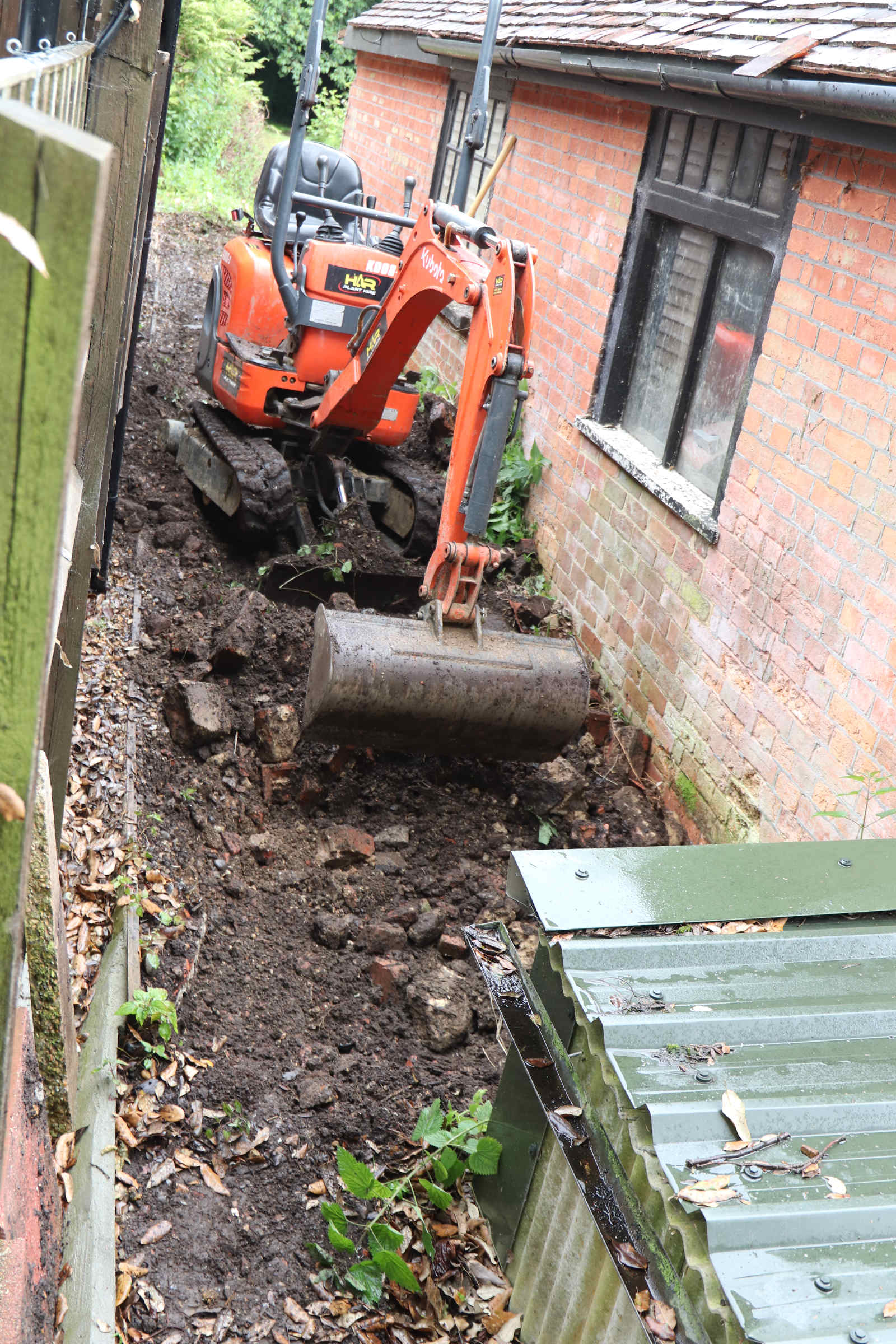
PROOFS
- Excavation
inside of a 3 meter area in relation to adjacent buildings, and 6 meters
at a 45 degree angle, could
undermine the provisions of the Party Wall Act as may be alleged. This
digger is clearly excavating within the prescribed (safe) distance of
the Generating Station. The County Archaeologist was informed, to record
the event in case of any future subsidence arising.
DOMINANT AND SERVIENT OWNERS
In the context of easements, the terms "dominant" and "servient" refer to the relationship between two properties:
A. Dominant owner: This is the property that benefits from the easement. For example, if a property owner has the right to access a neighboring driveway, that property is the dominant owner.
B.
Servient owner: This is the property that is subject to the easement. In the example above, the property with the driveway is the servient owner.
RESIDENTS PROPERTY COMPANY AS SERVIENT OWNER
If a residents' property company owns and maintains a driveway that is used by multiple properties, it would typically be considered the servient owner. This is because the company's property is subject to the easement rights of the individual property owners who use the driveway.
In such a scenario, the dominant owners (the individual property owners) would have the right to use the driveway, while the servient owner (the residents' property company) would have the responsibility for maintaining and managing the driveway.

RAINBOW,
MARCH 18 2019 - A sign from above as to the worth of this local historic asset, or perhaps a warning to would be
usurpers? However this rainbow may be interpreted, what is for sure is that four years
before this photograph was taken, the same phenomenon was captured on film to remind us that we should
revere nature.
Traditionally,
a rainbow is a reminder of God’s promise that he will never destroy the earth with a flood again. In the story of Noah we find a world of people who have forgotten about their Creator, choosing to live selfishly and without regard for one another or God.
How then should this repeated sign be interpreted. Biblically, or is it
just a coincidence?
This field
in this picture is prone to flooding, perhaps a reference to the Biblical cleansing and survival of Noah, his family and the animals that sought refuge in the
Ark. Or,
perhaps, to leave well alone, and respect natural equilibrium. Copyright
photographs © 2019, Cleaner Ocean Foundation and Lime
Park Heritage Trust, all rights reserved.
EASEMENTS IN ENGLISH LAW - A BRIEF OVERVIEW
Easements are rights that one person (the dominant owner) has over the land of another (the servient owner). These rights are generally used for specific purposes, such as access, light, or support.
Parking Rights as Easements:
Parking rights can be considered easements. If a property has enjoyed the right to park on a neighboring property for a long period, this
may be established as an easement.
Prescription Act 1832 and Acquisition of Easements:
Under the Prescription Act 1832 (seen above in full with links below), it is possible to acquire an easement by prescription if the right has been exercised for a continuous period of 20 years
or 40 years. This means that if a property owner has been parking on a neighboring property without permission for at least 20 years, they may have acquired the right to do so as an easement.
But that such right becomes indefeasible after 40 years.
Preventing Usurpation of Parking Rights:
If an easement for parking rights exists, the dominant owner can generally prevent others from usurping those rights. This means that if someone else starts parking in the designated parking area without permission, the dominant owner can take legal action to protect their easement.
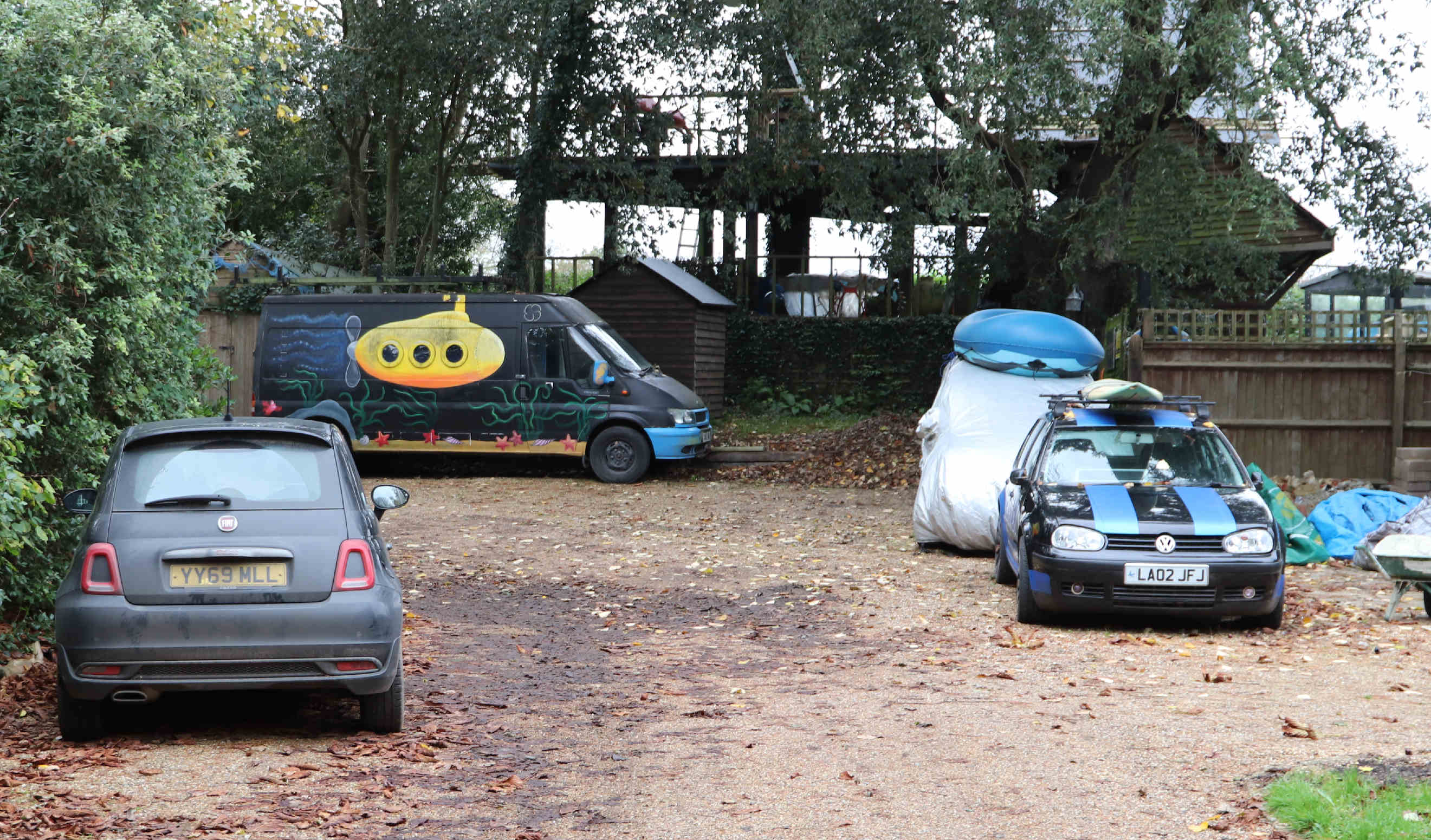
PARKING
PATTERN 2022
- Vehicles seen in this picture include a Fiat owned by Nigel Flood, a
Transit van, a Jeep and VW Golf. Existing users of the early electricity
generating station, have been parking along this drive in this position
since at least late 1981. But please note, the Museum does not encourage
visitors to use the shared drive which is reserved for the Trustees,
companies, volunteers and other operators working out of the premises.
Copyright picture © 2022 Herstmonceux Museum Limited.
OTHER IMPORTANT CONSIDERATIONS
Express Grant: An easement can be created by an express grant in a deed or other written document.
Implied Grant: In certain circumstances, an easement can be implied by law, such as when a property is sold and the use of a particular right is necessary for the enjoyment of the property.
Extinguishment: Easements can be extinguished in various ways, such as by abandonment, release, or the merger of the dominant and servient properties.
It is thus important that if you have acquired such rights, it is put in
writing, in the case of parking, the dominant party should write to the
servient party asking them to provide any evidence they may have to the
contrary. Should the servient party be unable to provide such proofs
after a reasonable period of time has elapsed, the right becomes
established in law as being indefeasible. The 'Right' then runs with the
land. This may be particularly important in the case of historic
buildings, that enjoy historic rights. As may benefit Conservation
Areas, proposed future, or previously granted.
In
the case of a Right To Light, the right may never be extinguished or
abandoned, unless for a period of time equivalent to the time it took to
acquire the right. Such that the right to extinguish the Right To Light,
becomes negatively abandoned. In other words, at least twenty years. The
same reasoning applies to Parking Rights. In other words, in practical
terms, once a right is established from long use, it is unlikely to
become extinguished.
WHAT
IS THE MEANING OF 'INDEFEASIBLE' ?
Many
people will not have come across the word "indefeasible" in
ordinary parlance, and may be confused as to the actual meaning.
Indefeasible means that a right or claim is not capable of being defeated or annulled. In the context of the Prescription Act of 1832, it implies that an easement acquired by prescription becomes a permanent and irrevocable right.
Once a right has been acquired through prescription, it cannot be challenged on the grounds that it was originally acquired without the owner's consent. However, it's important to note that there are still some limitations and exceptions to the indefeasibility of prescriptive easements. For example, an easement can still be extinguished if it is abandoned
for a prolonged period of time, or if the dominant and servient properties merge.
In essence, an indefeasible right is a secure and unassailable right that is protected by law.
Having
read the above, should you be in any doubt as to the meanings of any
part of Prescription law and Rights, you may want to consider consulting with a legal professional for specific advice on your particular situation.
Buyers and sellers beware! It pays to know your rights, and the rights
of others, before considering buying or selling a property. Especially,
to avoid claims under the consumer protection law.
CONSUMER
PROTECTIONS FROM UNFAIR TRADING REGULATIONS 2008
The Property Misdescriptions Act 1991 (Repeal) Order 2013 repealed the Property Misdescriptions Act 1991 on October 1, 2013. The repeal was made to replace the Property Misdescriptions Act 1991 with the Consumer Protection from Unfair Trading Regulations 2008 (CPRs) and the Business Protection from Misleading Marketing Regulations 2008 (BPR).
The Property Misdescriptions Act 1991 made it illegal to make false or misleading statements about property when advertising it for sale. The CPRs were intended to provide more general protection than the Property Misdescriptions Act 1991 and extend the duty of care that estate agents owe to their clients.
In
the case of relatively recent property sales in Lime Park, it could be
as alleged, that vendors and/or their agents may not have pointed out
the above law as well as they might. In addition, surveyors also have a
duty to point out any discrepancy between what appears to be registered
land (at the Land Registry) and what the actual position is on the land.
Since land displacement is more common in the countryside. Other issues
of importance concerning property descriptions include Tree Preservation
Orders (TPOs). Where, protected trees may make it impossible to assert
what vendors had suggested were rights to reconstruct demolished
buildings once they are removed. Making such land all but worthless, and
potentially a liability, rather than an asset. Since as the owner of
land, useful or not, there is a general duty of upkeep, such as not to
cause harm to adjacent buildings, or cause a Statutory Nuisance.
This
was so in the case of the Generating Station, that was seriously
overgrown and in danger of collapse in 1981. It was a liability that the
then owners, Nikolia
and Clare
Askaroff could well do without.
WHAT
MIGHT CONSTITUTE A STATUTORY NUISANCE?
Statutory nuisances are activities or conditions that are considered harmful to public health or welfare. They are generally defined by legislation and can include a wide range of activities, such as:
Environmental nuisances: These include pollution of air, water, or land, excessive noise, and offensive odors.
Public health nuisances: These include activities that are harmful to public health, such as the presence of rats or other vermin, or the accumulation of refuse.
Other nuisances: These can include activities that are considered unreasonable or offensive, such as excessive noise from parties or construction work.
EXAMPLES OF STATUTORY NUISANCES INCLUDE:
Excessive noise: Loud music, barking dogs, or construction noise.
Offensive odors: Smells from industrial processes, waste disposal sites, or livestock.
Pollution: Air pollution, water pollution, or land contamination.
Vermin: Rats, mice, or other pests.
Accumulation of refuse: Uncollected rubbish or waste.
Obstruction of highways: Blocking public roads or footpaths.
Dangerous structures: Buildings that are in a dangerous condition.
If you believe you are being affected by a statutory nuisance, you can report it to your local council or environmental health department. They will investigate the matter and take appropriate action if necessary.
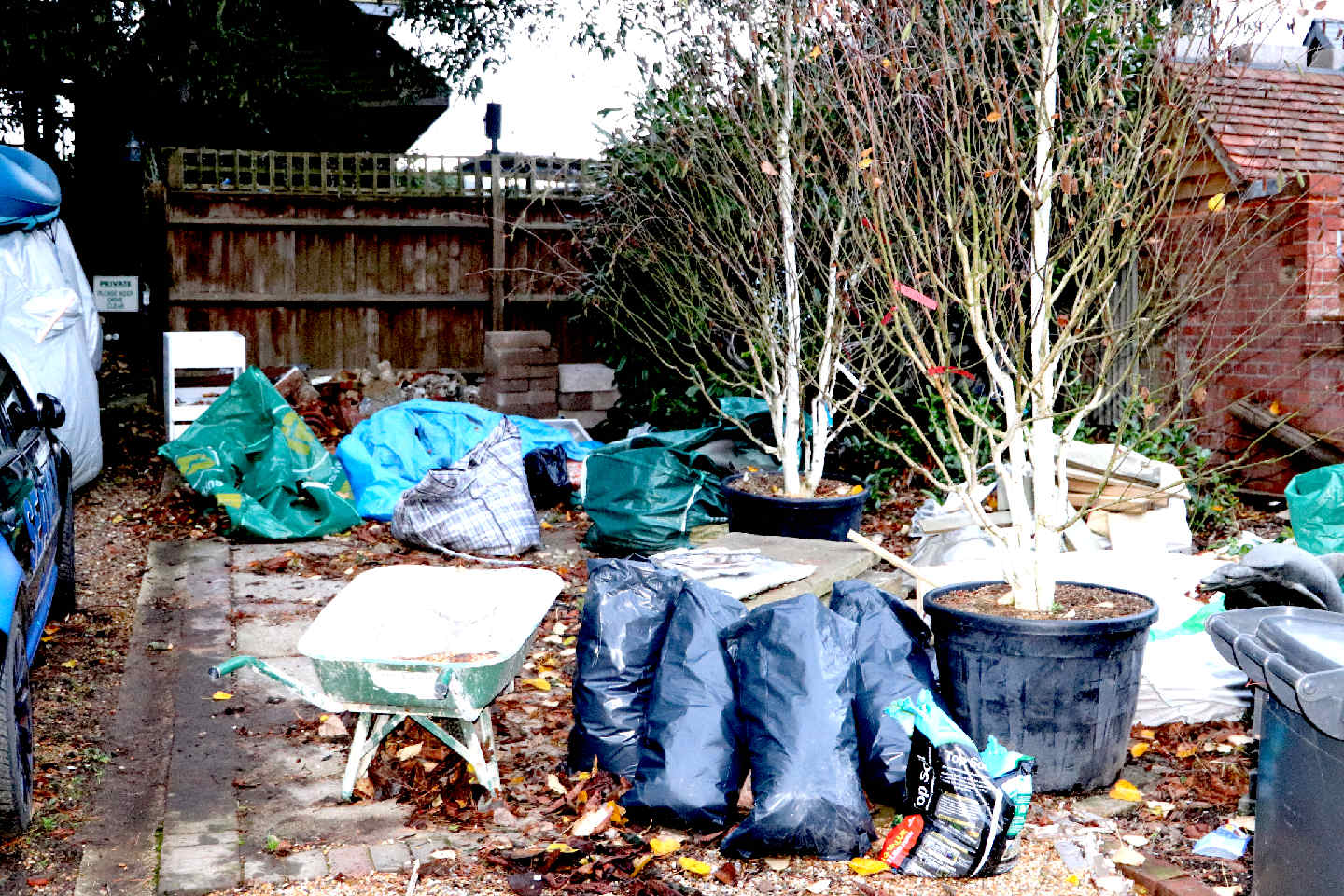
EXAMPLE
OF POTENTIAL STATUTORY NUISANCE
- This is an area of land that is open to the public visually, being
visible by the users of a shared drive, where rats have been noted in
the waste bags, and the situation largely unresolved in September 2024
(see picture below), being a virtual tip, allegedly. Copyright picture
© 2022 Herstmonceux Museum Limited.

STATUTORY
NUISANCE
- This is the same area of land that is open to the public visually,
being visible by the users of a shared drive, where rats and mice have
been noted in the waste bags, being kept as a virtual tip, allegedly.
Copyright picture © September 3rd 2024.
STATUTORY
NUISANCES & ENVIRONMENTAL PROTECTION
In the UK, statutory nuisances related to overgrown land, building waste, and similar issues are primarily covered by the Environmental Protection Act 1990. This legislation provides a framework for addressing public health nuisances and ensuring that environmental standards are met.
Specific sections of the Environmental Protection Act 1990 that might be relevant include:
Section 76: This section deals with "accumulations of waste" and can be used to address cases where excessive amounts of building waste are causing a nuisance.
Section 79: This section covers "other nuisances," which can include a wide range of activities or conditions that are harmful to health or a nuisance to the public, such as overgrown land that is causing damage to adjacent buildings.
Local councils have the power to investigate and take action against statutory nuisances. If you are affected by overgrown land or building waste, you can report the issue to your local council. They will assess the situation and determine if it constitutes a statutory nuisance.
It's important to note that the specific regulations and procedures may vary slightly depending on the location within the UK. If you have concerns about a particular nuisance, it's advisable to consult with your local council or a legal professional for more specific advice.
Additionally, there may be other relevant legislation, such as the Anti-Social Behaviour, Crime and Policing Act 2014, that could be applicable in certain cases.
When the making of an Anti Social Behaviour Order (ASBO) might be
appropriate.
https://www.legislation.gov.uk/ukpga/Will4/2-3/71/introduction

PROOFS
HERITAGE
TRAGEDY? - Demolition of the stables/forge building roofline in 2022.
The wooden shed with tin roof, clearly visible in the 'Google Maps' satellite
view to the right, having been already demolished. What other rights
might this affect, and have the owners of this building taken legal
advice before proceeding with such works. Obtaining planning permission
for a building or alteration, does not destroy the prescriptive rights
of dominant occupiers.

PROOFS
JULY
2022 - The original roofing line was extended unsympathetically (in
archaeological terms) over the footprint of the tin (potting) shed, and
past that footprint east by a considerable amount. Way past the block
that identified the origins of the stable courtyard; altering the
character of the equine origins of the complex. Property developers
frequently ignore 'character' in the quest for greater floor area to
assist uplift in property value when selling on. A property developer
need not be a typically commercial enterprise by a limited company or
partnership, but a private owner/occupier, taking advantage of capital
gains tax laws over a number or years, as they move from one conversion
to another, profiting as they go. Alternatively, properties may be
purchased and left in Trust in a Will to offspring to avoid Death
Duties.

WATER
RIGHTS - The ancient
well in Lime Park, benefits from indefeasible Water Rights, said
water coming from the adjacent field that feeds the aquifer filling the
well. Such right to water is also protected in law by the extant Water
Regulations and the Offences Against the Person Act of 1861, wherein it
is an offence to poison or to threaten to poison a water supply. Or
annoy any dominant person benefiting from such water supply, by interfering
with such right.
CHAPTERS:
ELECTRICITY AT HERSTMONCEUX, EAST SUSSEX
If
you know of any information that may help us complete this story, please get in
touch. We reserve the right to make alterations to existing text as new
facts are harvested. Though thought to be accurate at time of
publishing.
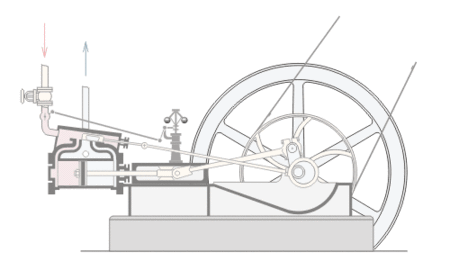
|












